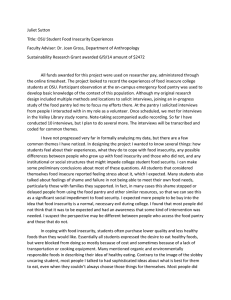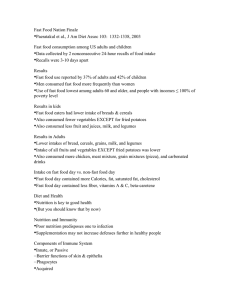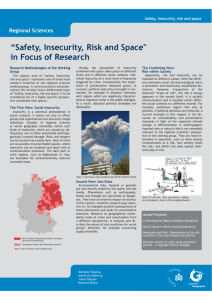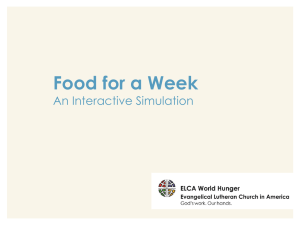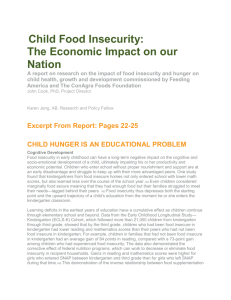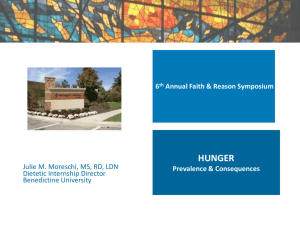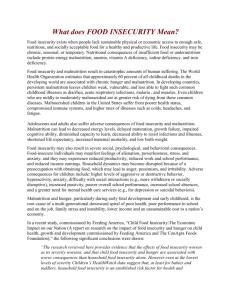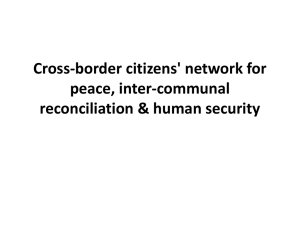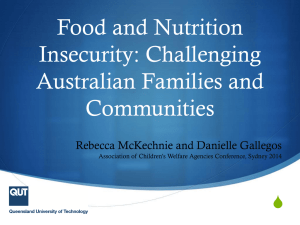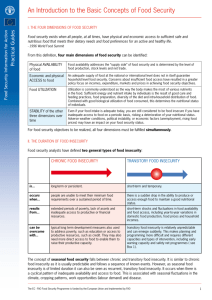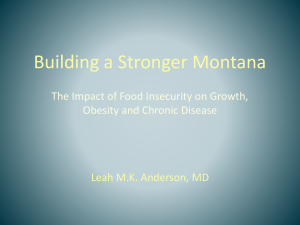Food Security Focus Group Research Project
advertisement
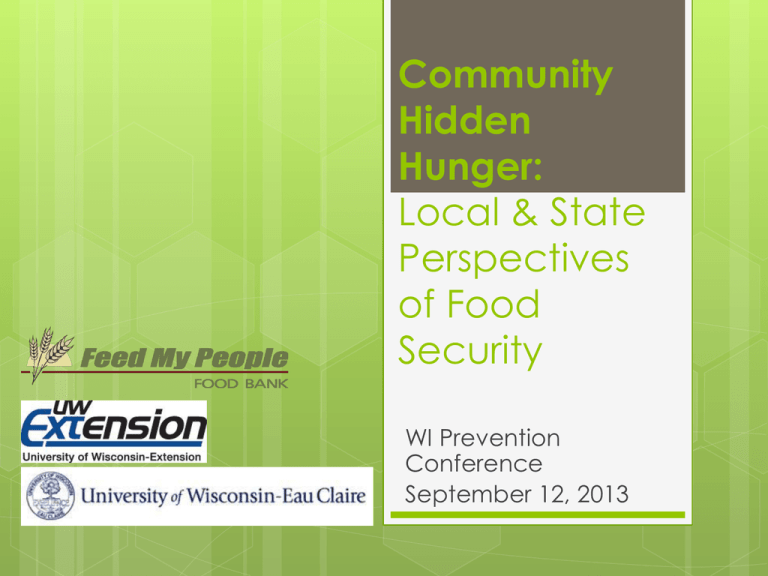
Community Hidden Hunger: Local & State Perspectives of Food Security WI Prevention Conference September 12, 2013 Overview Defining food security Food security focus group research project Framing food security and it’s relationship to community health Defining Food Security Definitions Food Security Access by all people at all times to enough food for an active, healthy life and includes at a minimum: The ready availability of nutritionally adequate and safe foods and The assured ability to acquire acceptable food in socially acceptable ways Food Insecurity Limited or uncertain availability of nutritionally adequate and safe foods or limited or uncertain ability to acquire acceptable foods in socially acceptable ways. Prevalence of Food Insecurity Food Insecurity Rates, 1996-2010 16 14.6 14 Wisconsin Food Insecurity Rate (%) 11.4 11.3 12 10 United States 11.0 10.4 8.5 8.4 9.0 11.8 9.0 8 6 4 2 0 1996-1998 1999-2001 2002-2004 2005-2007 2008-2010 State averages mask regional variation in food hardship State averages mask regional variation Poverty is the most important predictor of food insecurity…and yet, More than half of food insecure households are not poor Community Hidden Hunger: Food Security Focus Group Research Project Research Team Members University of Wisconsin-Eau Claire Mary Canales, Nursing Brenda Kaczmarski, Nursing student Meghan Lynch, Nursing student UW Extension, WI Nutrition Ed. Program Nancy Coffey, Nutrition Coordinator Melissa Gullickson, AmeriCorp Feed My People Food Bank Emily Moore, Director EC County Food Insecurity 1 in 5 children food insecure (Feeding America, 2012); 1 in 8 residents reported food hardship (FRAC, 2011); 1 in 5 residents participated in FoodShare/SNAP (DHS, 2011); 2 in 5 children enrolled in Free or Reduced Price lunch (WI Food Security Project, 2011). Research Project Purpose • Explore meaning of food insecurity through voices of food insecure parents with young children & agency staff from food assistance programs Methods • • • Community-based participatory action approach Multiple recruitment strategies Focus group methodology used to collect data Focus Group Questions Based on community advisory discussion roundtable Key question: What is it like to be food insecure? Theme 1-Why are people hungry? Theme 2- What does it mean to be hungry? Theme 3: What is working? Suggestions? Survey Data Collected Parent: USDA food security questions Household demographics Assistance programs utilized Staff: Job role Work experience & education Assumptions Experience of being hungry different for parents receiving government assistance compared to those who do not Plan=separate focus groups Reality=include anyone self-reported Incentives necessary to recruit Plan=logistical & monetary incentives would be sufficient to recruit desired numbers Reality-= insufficient; required connections Funding UWEC Office of Research and Sponsored Programs (ORSP) studentfaculty collaborative research grants Summer 2012 Academic Year 2012-13 UW-Extension (2012) Feed District Innovative Grant My People (2012) Human Subjects Research team members completed human subjects certification training Proposal submitted, reviewed & expedited by UW-EC IRB Each participant signed consent & received a copy for own records Requested & received permission to digitally record focus group discussions Recruitment Efforts Met with representatives from agencies affiliated with food insecure population Focus Group Facilitator- personally experienced food insecurity Compensation offered-$25 gift card (grocery or gas) Convenient location-Children’s Museum; included free admission Child care provided Snack & beverage provided Offered variety of dates & times of day Reminder phone call or email day before Challenges Encountered Despite initial interest, low attendance Touched Twice Clinic: 35 signed up; 7 agreed; 2 attended (1 group) ECASD: 7000 bookmarks; 30 inquiries; 19 attended (3 groups) Augusta Area School District: 12 hours visibility=1 signed up Stigma associated with hunger negatively influenced participation Without personal connection, limited response Recruitment Tool: Bookmark Successful Recruitment Approaches Connect to staff affiliated with existing programs; build upon these relationships Ask staff to assist with recruitment & invite potential participants Host in location familiar & easily accessible to participants; provide transportation Results Summary of Participants Date Focus Group Type Number of Participants Time Location May 7, 2012 Pilot group-parents 2 9-11 am Children’s Museum July 16, 2012 Hmong Head Start parent group 10 12-2 pm September 11, 2012 Transitional housing & Abuse Shelter EC school district parent group EC school district parent group EC school district parent group Augusta & Fall Creek school district parent group 8 9-11 am Hmong Mutual Assistance Association (HMAA) Western Dairyland 3 6-8 pm Children’s Museum 9 12-2 pm Children’s Museum 7 12-2 pm Children’s Museum 4 9-11 am Fall Creek Librarycommunity room Staff 8 3-4:30 pm HMAA October 3, 2012 October 5, 2012 October 19, 2012 November 12, 2012 March 1, 2013 Total 43 parents 8 staff Results from Survey Data Over 35% half had 2 children or less had children 5 years or under Majority families 23% were couples or 3 generational were minority population (Hmong) Over half had annual income of $20,000 or less Survey Results: Coping with Food Availability During the past 12 months: o 72% participated in FoodShare & free or reduced cost school lunch o 50% participated in WIC or used food pantries o 43% reported they cut size of or skipped meals almost every month o 40% said they often could not afford balanced meals Focus Group Analysis: Themes that Emerged Falling through the cracks Struggling physically & emotionally with hunger Juggling Desiring means to meet life’s basic needs healthy foods without the Themes were consistent for parent and agency staff participants. Parent: Falling Through the Cracks …the day I call to say, ‘Hey, I got a job. It’s a temporary position, contracted 160 hours.’ As of that day…she’s [agency staff] like ‘well, you won’t get any food stamps next month then.’ Meanwhile you’re really hungry at work and haven’t gotten paid yet. And then sometimes they hold back a check, too. Yeah, it took me 4 weeks to get my first check … Staff: Falling Through the Cracks I think there are a lot of families that are falling through the cracks, that don’t qualify for programs, but still aren’t able to feed their families, especially if they have children. They aren’t necessarily homeless families or anything like that, but they’re falling through the cracks. Parent: Struggling Physically & Emotionally with Hunger …when there is enough [food], I can sleep, when there isn’t enough, I just couldn’t sleep – I can’t fall asleep. It’s very different, because when there isn’t enough [food], the stress level there is just super high, kids will be nagging, crying, and when you do have enough it is exactly the opposite, everybody is happy. Staff: Struggling Physically & Emotionally with Hunger … she [Mom] said, ‘No, that’s your dad’s cheese. He’ll be mad if you eat it.’ So she decided to give him some, so she got a little cup out and gave him about this much shredded cheese to share with his one year old sister. And then he [son] said he wanted something else to eat and she [Mom] said, ‘no you can’t have anything more.’ Parent: Juggling Life’s Demands When we run short on food we go to food pantries, free meal sites, just to…okay it’s getting towards the end of the month. We’re running short, we have to find ways to stretch it. But I don’t have a car so getting around is another thing, so when I’m having to spend (buy food) at the gas station it goes quick so then you have to figure out how to stretch it the rest of the month. Staff: Juggling Life’s Demands We’ve had people apply and one of the big obstacles for them is medical bills, and unfortunately, our applications don’t take into consideration any medical bills. It’s based on gross income, so that’s tough for the families with medical issues. Parent: Desiring healthy foods without the means …I would just love to just be able to eat healthy, you know, every single day. I, if I had the means I would eat healthy and feed my kids healthy… Staff: Desiring healthy foods without the means It has to be that we’re going to teach how to choose it (other staff: uh huh), what to do with it, how to prepare it and how to store it. It’s a lot of things, it’s the reading level, it’s the recipes. Do you have the cooking ability at home? All of those things, it’s pretty complex. ECC Food Security Action Increase • • community awareness Turning the Tables on Food Hardship Media Campaign A Place at the Table documentary film event Educate & mobilize health care providers Foster coalitions & networks to take action to address food insecurity. Framing Food Security Framework for Food Security (USAID) Access Availability Utilization Wisconsin Food Security Project Framework for Food Security Economic Context that Supports Economic Wellbeing Strong federal food and nutrition programs Strong emergency /charitable food system Affordable and accessible local food system Understanding how poverty impacts health The cyclical effects of poverty Broadening the focus of health Connecting food insecurity to health Nutritional deficiencies during pregnancy Nutritional deficiencies Low birth weight or premature birth Overall poor health Cognitive, behavioral and physical problems in youth Food Insecurity Chronic stress and harmful home environments Gestational diabetes during pregnancy Diabetes & chronic disease Obesity Lack of availability and access to healthy, affordable foods Food insecure and obese? Growing body of literature primarily based on crosssectional studies, limited availability of longitudinal studies Difficult to determine causal relationship Most consistent findings suggest relationship of food insecurity and risk for obesity among women…children (mixed evidence) and adolescents (growing evidence) Maternal stress/depression Disruptive eating patterns (cycles of deprivation/overeating & sacrifice food supply) Consumption of low-cost, poor-quality foods Some factors may place lowincome individuals at greater Greater exposure to junk food marketing risk for obesity Lack of access to healthy, affordable foods Cycles of Food deprivation and overeating High levels of stress Fewer opportunities for physical activity ACTIVITY: Creating a strong community food security infrastructure Implications: How Can Food Insecurity be Reduced? Thinking of your community: Identify root causes/contributors of food insecurity Brainstorm ideas to reduce food insecurity Identify 2-3 ideas to move forward Power Map the stakeholders you would invite to the table Conduct 1:1 interviews with stakeholders Take action! Identify1-2 food security related health issues of major concern in your county/community Nutritional quality of available food Mental health, stress, depression Housing & Homelessness Transportation Limited job & employment opportunities Livable wages Educational attainment Alcohol & Drug Abuse Health Care Access & Quality of Care Other – specify _______________ Considering these issues, how can the food security infrastructure in your community be strengthened? Food Security Infrastructure Economic Wellbeing Federal food and nutrition assistance programs Local food access and availability Emergency food assistance Your Ideas 1. 2. 3. 4. Identify stakeholders to bring to the table 1. 2. 3. 4. 5. 6. 7. 8. 9. 10. 11. 12. 13. 14. Group Discussion Thank you! Today’s Presenters Mary Canales CANALEMK@uwec.edu Amber Canto amber.canto@ces.uwex.edu Nancy Coffey nancy.coffey@ces.uwex.edu Brenda Kaczmarski kaczmabj@uwec.edu Acknowledgements Amy Korth UW-Extension Cooperative Extension
